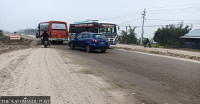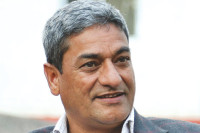National
Government slashes share of targeted power generation from reservoir type projects
Except 140MW Tanahu Hydro, no other reservoir type project has moved in the direction of construction.
Prithvi Man Shrestha
When the government introduced a concept paper on the National Energy Crisis Alleviation and Electricity Development Decade in 2016, it had set the target of producing 10,000 megawatts in 10 years.
Of the total targeted power production, the government planned to generate 40-50 percent of power from pumped storage type hydropower projects.
The government reduced the ratio of pumped storage type projects in the total generation mix to 30-35 percent when it introduced a white paper on energy, water resources and irrigation in 2018. As per the white paper, the government aims to produce 15,000MW of electricity by the fiscal year 2027-28 with 10,000MW for domestic consumption.
The government has further reduced the share of pumped storage type projects in the total generation mix, although the importance of more storage type projects has long been felt since the country has to import power in the dry season, increasing Nepal’s vulnerability in terms of energy security.
“The share of storage and pumped type projects in the total generation mix was reduced to 20-25 percent in the latest decision of the cabinet last month,” said Madhu Bhetuwal, spokesperson for the Ministry of Energy, Water Resources and Irrigation. “The target related to the share of power to be generated from run-of-the-river type projects has been increased to 40-45 percent.”
He said that the electricity generation target from storage projects has been reduced as there is little possibility of developing such projects in the next few years.
Currently, Kulekhani I, Kulekhani II and Kulekhani III are the only storage type projects that are producing electricity. Their combined capacity stands at 106MW.
The 140MW Tanahu Hydropower Project, which is also a reservoir type plant, is expected to produce electricity in the next few years, according to Bhetuwal.
“Our aim is to produce 15,000MW electricity even by increasing the share of the run-of-the-river type projects,” said Bhetuwal.
But the country’s need for storage type projects was largely felt when it had to cut power for industries for up to 14 hours a day for two months since late March after electricity supply from India was disrupted amid reduced production of power in the southern neighbour due to coal shortages.
India is heavily reliant on coal-fired power plants to produce electricity; due to the Russia-Ukraine war, India failed to produce enough electricity.
As Nepal cannot produce enough electricity in the winter due to reduced water levels in the rivers, it has to rely on supply from India to meet the power needs in the country. Amid reduced supply, the Nepal Electricity Authority had to cut power to the industries four years after it ended load-shedding even for the industries in May 2018.
“This crisis shows that Nepal needs storage or the peaking run-of-the-river type projects to ensure energy security,” said Suresh Bhattarai, the NEA spokesperson. “We are heavily reliant on the run-of-the-river type hydropower projects which don’t produce enough power in the dry season due to reduced water levels in the rivers.”
Though Nepal has been exporting power in the wet season, during the dry season, it has to import electricity.
The wet season in the country lasts from May to November while the dry season starts in December.
“Even without the contribution of storage type projects, our projected power generation will be enough to sustain dometic demands in the next three years even during the dry season,” Prabal Adhikari, chief of the NEA’s power trade department, said at an interaction organised by Urja Nepal, a USAID-funded initiative in Kathmandu, on Wednesday. “But there is the question whether all the under-construction projects that are expected to generate electricity within the next three years will be completed.”
He said that the country will have to continue buying power from India if the under-construction projects are not completed as per the existing timeline.
Initially, contributions of reservoir type projects in the overall power generation mix were kept higher considering that the country was facing acute load-shedding, particularly in the dry season.
But officials said investors are not attracted to such projects because of high costs.
“The power purchase rate being offered currently is not enough to make up for the cost required to build reservoir type projects,” said Bhetuwal. “So the state has to provide viability gap funding.”
Reservoir type projects also affect more areas, and rehabilitation and resettlement of people affected by the project increases the cost of the project.
So, there is limited interest in developing such projects.
In fact, the share of reservoir type projects in total projected generation from the projects which have applied to the NEA for power purchase agreements is around seven percent only, according to the NEA. Projects with combined generation capacity of 11,391MW have so far applied for PPA, according to the power utility.
“Despite a limited number of reservoir type projects, the door opened for cross-border power trade has enabled Nepal to receive power even during the dry season,” said Bhetuwal. “We have to develop reservoir type projects, too, but the immediate concern is how to increase electricity consumption in the wet season.”




 13.12°C Kathmandu
13.12°C Kathmandu















